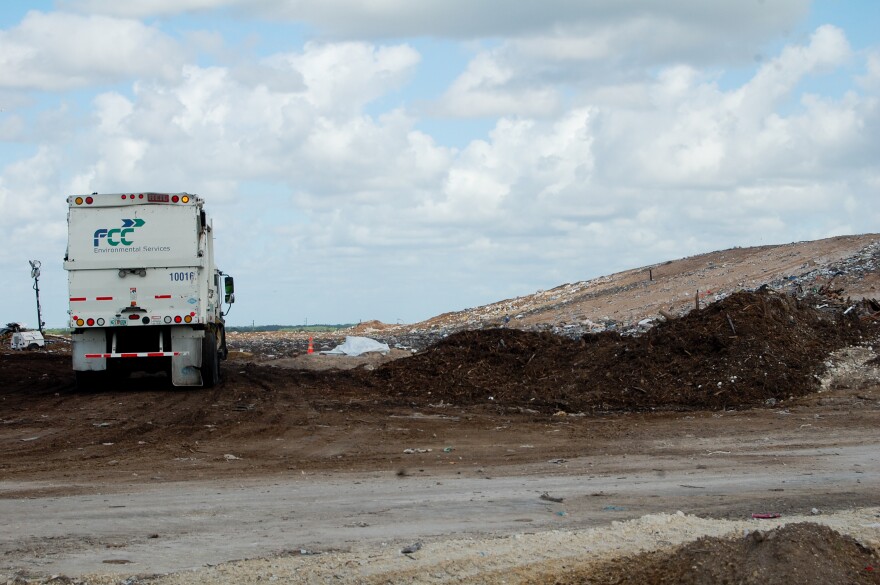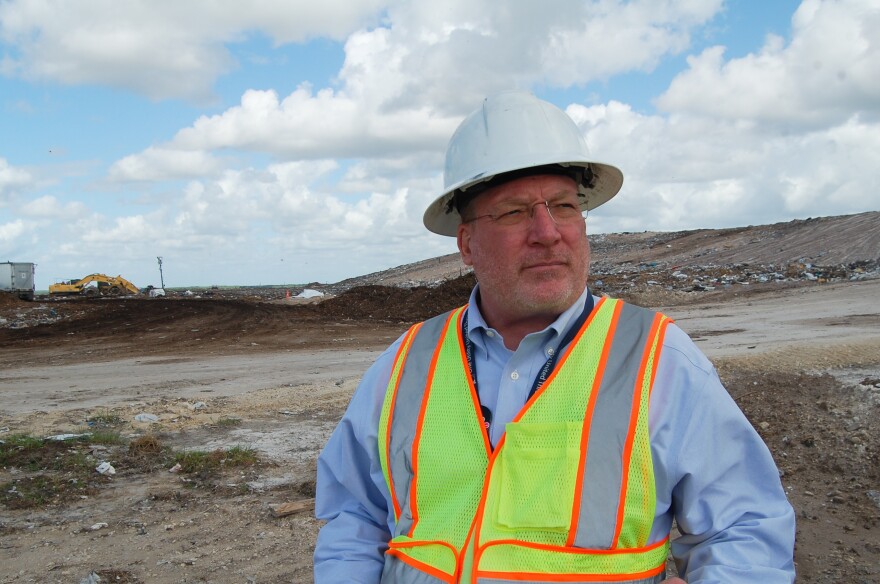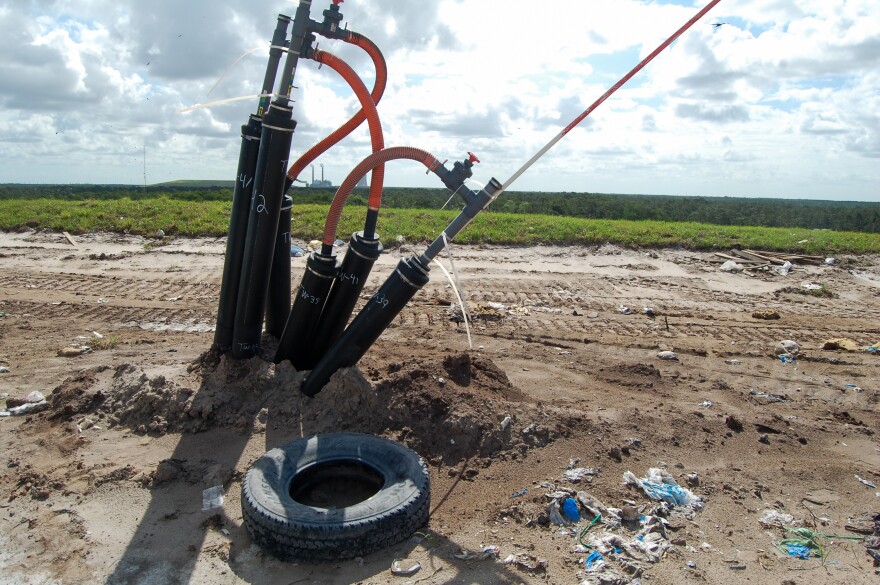A single flip-flop. An empty Chick-fil-A sandwich bag. A mattress. A sneaker, navy with a white sole. A little orange bouncy ball.
Garbage is strewn among thigh-high drifts of dirt, used to bury the filthy, weather-worn items at the Orange County Landfill in Florida and prevent the intrusion of insects, rats and pigs. Bulldozers smooth the dirt into place while tractor-trailers deliver ever more trash. Vultures and seagulls circle above. A bald eagle lands nearby.
"Anything you will see out in the real world you'll see it here," said David Gregory, manager of the solid waste division of the Orange County Utilities Department. "Because when people throw things away, this is where it comes."
According to the Environmental Protection Agency, landfills such as this one on the edge of Orlando are among the nation's largest sources of methane, a greenhouse gas far more potent than carbon dioxide and a major contributor to global warming. A seminal U.N. report published in May found that immediate reductions in methane emissions are the best, swiftest chance the planet has at slowing climate change. Landfills emit methane when organic wastes such as food scraps, wood and paper decompose.
But the challenges to reining in methane are big, beginning with even quantifying how much leaves landfills. Industry operators insist the EPA overestimates emissions. Yet independent research looking at emissions from landfills in California and a top EPA methane expert said that the agency significantly underestimates landfill methane.
The EPA has "been understating methane emissions from landfills by a factor of two," said Susan Thorneloe, a senior chemical engineer at the EPA who has worked on the agency's methane estimation methods since the 1980s.
Part of the problem may be that the EPA's methods for estimating landfill methane emissions are outdated and flawed, Thorneloe said.
Ryan Maher, an attorney with the Environmental Integrity Project, a watchdog group, said landfill methane emissions are "a neglected problem."

"We're basing our emissions estimates on models rather than direct measurement," said Maher, who recently authored a study that found Maryland's landfill methane emissions were four times higher than that state had estimated. "We do have the capacity to measure these emissions directly. And we just haven't been."
The stakes are high for getting an accurate picture of methane emissions. Reducing methane could almost immediately curb climate change, because it stays in the atmosphere for a short time, unlike carbon dioxide, which lingers for a century or more. Landfills are one of three main sources of human methane pollution, along with livestock and the oil and gas industry. The United States is the third-biggest emitter of methane in the world.
The Biden administration has begun to implement a 2016 rule on landfill methane, but it will only cut a small percentage of emissions. Yet steep reductions in global methane emissions this decade would avoid nearly 0.3 degrees Celsius of additional warming by the 2040s, according to the U.N. assessment. That could go a long way to keeping average global temperatures from rising beyond 1.5 degrees Celsius compared with preindustrial times, and avoiding the worst effects of climate change, a goal of the Paris climate agreement.
"By reducing methane emissions, we can quickly reduce the atmospheric warming effect," said Jeff Chanton, a Florida State University climate scientist who studies methane. "And targeting landfills is a great place to start because by tuning the gas collection system, and getting it to work at its optimum level, you get a lot. You collect more methane, and you don't release it to the atmosphere."
Loading...
Three of the top 10 methane-emitting landfills are in central Florida
Standing atop a 140-foot summit of refuse at the Orange County landfill, almost all of metro Orlando is in view: downtown high-rises, the control tower and runways of Orlando International Airport, and the looming cylinder-shaped cooling towers of Stanton Energy Center. It powers some 260,000 homes and businesses in Orange and Osceola counties, up to 15,000 of them with methane from this landfill.
Gregory finds value in what is going on under his feet, the rotting and decomposition of organic waste such as kitchen scraps, paper or spoiled canned goods, and the biological processes that turn garbage into methane. Buried within the garbage lies an expansive criss-cross network of more than 500 wells capturing methane gas from the decomposing trash. The wells also keep vast quantities of methane from escaping.
"You have something that's reached the end of its life," he said of the trash. "And one of the things that we do here at the landfill is collect that gas and use it to make energy."
The EPA tracks more than 2,600 municipal solid waste landfills. About 500 collect methane for energy production. The agency estimates that nearly 500 more could cost-effectively have their methane turned into an energy resource.
Projects such as these could play a key role in stemming the worst impacts of climate change.

Despite landfill operators' efforts nationally, large volumes of this invisible, odorless gas still escape from the sites each year. For all the emissions the Orange County Landfill captures, for example, an additional 32,000 metric tons of methane were released from the facility into the air in 2019, making it the third-largest source of methane emissions from a landfill in the country, according to the most current public information the company reported to the EPA. That represents a large, inexplicable increase from previous years — Orange County hadn't been a top 10 emitter in the decade before 2019, according to EPA data.
The Orange County site isn't alone in central Florida. Three landfills among the nation's top 10 emitters of methane are near Orlando, according to the EPA. Their collective emissions damage the climate in the near-term as much as all the 1.8 million cars and pickups registered in the three counties where the landfills are located.
For Orange County, the high ranking came as a surprise — an unwarranted one, officials said. Community leaders here take pride in sustainability initiatives. They consider the landfill's methane-to-energy system key to reducing greenhouse gas emissions.
Orange County's Gregory said he is reevaluating what the county has reported to the EPA.
"It's not like we have a measurement" of methane emissions, he said. "It's all based on the models. And that's where we need to make sure that we're not overlooking anything."
A spokeswoman for the top methane-emitting landfill in the nation, a facility near Cincinnati operated by Rumpke Waste & Recycling, also said the EPA ranking was misleading.
In an email, spokeswoman Amanda Pratt dismissed the emissions values her company reported as based on "a theoretical methane generation rate that is calculated using facility-provided data and US EPA derived equations."
Loading...
Outdated methane emissions models create "a mess"
EPA figures may indeed be flawed.
A 2018 National Academy of Sciences report placed "low confidence" in EPA estimates for landfill methane emissions due to uncertainties and insufficient measurements. The report concluded that the agency's method for estimating methane emissions from landfills is "outdated" and was "never field-validated."
Further, the EPA allows for three different ways that individual landfill operators can calculate the amount of methane they generate and two different ways to calculate how much of that methane is emitted into the atmosphere. Depending on which methods an operator chooses, the estimated amount of methane emissions can vary significantly.
The EPA's Thorneloe helped craft the current estimate method, and she said it "was developed over 30 years ago using empirical data for about 40 landfills."
Citing new research out of California, she has come to believe the agency underestimates emissions.
Landfill operators agree that the EPA models are flawed but insisted those flaws lead to overestimating emissions from their sites. In a statement to NPR, David Biderman, chief executive officer of the industry group Solid Waste Association of North America, said, "The model relies on many assumptions and has not been updated to reflect changes in the waste sector such as reduced organic content in the waste stream that can result in overestimation of landfill emissions."
Jean Bogner, a University of Illinois at Chicago emeritus professor and a co-author of the National Academy of Sciences report, calls the EPA's methods "a mess." Bogner, in part, blames the deficiencies on methods first developed by the Intergovernmental Panel on Climate Change, a U.N. body.
"Methods should evolve with the science," Bogner said. "It's becoming more and more important as we move into more intensive climate change mitigation strategies to understand more precisely how much methane is coming out of specific landfills. In the past, you could sort of wave your hands and say, 'This may be a ballpark number,' but we need better numbers now to guide site specific mitigation strategies."
The National Academy of Sciences report made recommendations to improve methane measurement, and the EPA is working to address those that pertain to the agency, an EPA spokesperson said in an email.
More broadly, EPA officials said they continually update estimates. The agency is reviewing scientific studies on landfill waste to better inform the agency's estimates for methane emissions, the spokesperson added.
Thorneloe said better measurement technologies will help EPA staffers make better estimates.
"If we're going to choose particular sources to reduce emissions, we need to know what those emissions are," Thorneloe said. "What I'm trying to do is develop better test methods rather than what we've relied on in the past."
Industry representative Biderman said that "any proposed changes to regulations should be technically feasible and commercially available."

With landfill gas capture systems, efficiency counts
Capturing methane at a landfill is complex. A lot can go wrong with a landfill's plumbing, said Chanton, the Florida State University climate scientist. "It's very vulnerable to disruption," he said. "It takes a lot of attention."
Landfills aren't like a factory that sends nearly all emissions through individual smokestacks. Landfills can span hundreds of acres and leak at various rates from open areas or sections that have temporarily been covered or permanently closed and capped.
Operators have up to five years to start capturing methane from new landfill sections, called cells. But methane pollution begins much sooner than that, said Morton Barlaz, professor and head of the Department of Civil, Construction and Environmental Engineering at North Carolina State University.
The capacity to collect methane at landfills often depends on gas capture wells and how efficiently the collection system is operating. Landfill operators are required to cover waste disposal areas every night with a thin layer of soil or an alternative such as mulch or even plastic. Some of those materials are more porous than others, resulting in more methane releases, Barlaz said.
Weather can also play a role. Rain can both help produce more methane and flood gas collection systems, making them less effective.
"When you have a situation where your gas collection is impeded, the landfill will emit more methane than EPA estimates might suggest," Chanton said. But a well-run system can collect more methane in its wells while also harnessing methane-digesting microbes in the landfill's soil cover to help neutralize the greenhouse gas before it can escape, he added.

Flights over landfills identify climate threats from "super emitters"
One hope for getting a better grip on methane emissions involves NASA and monitoring landfills from airplanes or space.
Riley Duren is a former engineer with the space agency's Jet Propulsion Laboratory in California who now works as a research scientist at the University of Arizona. He's also chief executive officer of Carbon Mapper, a new nonprofit consortium. Carbon Mapper announced in April it was launching "a constellation" of methane-sensing satellites with partners that include NASA, the state of California and various universities and organizations.
It's an extension of the California research praised by Thorneloe that, between 2016 and 2018, involved flying over hundreds of California methane emitters such as oil and gas operators, animal manure facilities and landfills. Published in 2019 in Nature, the study identified what Duren, the lead author, described as a small but substantial number of methane "super emitters." As many as 40% of those were landfills.
"Some of these landfills were emitting huge amounts of methane," far more than what the landfills were reporting, Duren said. "I am talking tons per hour of methane."
Many landfill operators take methane controls seriously, Duren said. But the massive leaks occur when gas capture systems are offline or workers are installing new systems. "And in other cases, it's the result of flawed management practices in terms of how the landfill is managing the daily cover," he said.
The satellites could help landfill operators find problems quickly so they can fix them, Duren said. That work is essential if the United States is going to meet the Biden administration's commitment to cut U.S. greenhouse gas emissions by 50% by 2030.
Focusing on super emitters could be an effective step. Duren said: "It's a smaller amount of the infrastructure ... that if we can target, there can be dramatic reductions over the next few years."

EPA takes a modest step to curb landfill emissions
In May, the EPA implemented a 2016 Obama-era rule that will extend existing requirements for methane collection systems to 93 additional landfills. It lowers the emissions threshold for when landfills must install gas collection systems. Once in place, the rule will cut landfill methane emissions about 7% nationally.
The regulator also told about 40 states with about 1,600 landfills that lack EPA-approved landfill gas capture plans that they needed to get one, or the agency would enforce its own.
Biderman of the Solid Waste Association of North America said the EPA's move "should result in further reductions in emissions, continuing a trend which the industry has been investing in for decades."
To many scientists and advocates, the EPA's action falls far short of what's needed for the climate — and what's possible with existing technology. The agency's plans will have little effect on landfills that were already required to capture methane under an older rule, and the EPA should have lowered even further its threshold for requiring capture systems to make smaller landfills cut methane, said Maher of the Environmental Integrity Project.
In Maryland, for example, state officials are creating a landfill methane regulation. But if the EPA rules get adopted in Maryland, they would "only apply to four out of 40 gas-producing landfills in the state," Maher said.
The recent U.N. methane assessment goes even further. It calls for ending the practice of sending organic waste such as food scraps to landfills. Such waste should instead go to compost facilities or specially designed digesters that reduce or capture methane emissions better.

Landfill operators respond to their high EPA rankings
For their part, some landfill operators are scrambling to show why the EPA rankings are wrong and to explain what they are doing to reduce their emissions.
At the Rumpke landfill near Cincinnati, company spokeswoman Molly Yeager explained its top EPA ranking by pointing to a second alternative emissions model the company also used with some direct measurements that yielded lower emissions estimates. She said that by default, the EPA selected the higher number. An EPA spokeswoman agreed the reporting system defaults to using the higher of the two equations, but she added that landfill operators can choose the results of the other equation if they believe it better represents conditions at the landfill.
Central Florida is among the fastest-growing regions in the nation. In Brevard County, on the state's east coast, keeping up with the booming population and volume of trash presents a challenge to controlling methane emissions, said Thomas Mulligan, assistant director of the Brevard County Solid Waste Management Department.
"I know fully well that we have been in the top 10 for a while now," said Mulligan, who oversees the Brevard landfill some 45 miles east of Orlando. "It is really tough."
Like other industry representatives, he said he believes the EPA's reporting methods overestimate emissions. But he also said Brevard County could do more to reduce landfill emissions. For example, the county could speed installation of a gas collection system in the landfill expansion, he said.
"It's a matter of capital improvement money, and it's a matter of timing," he said.
The JED landfill, situated some 54 miles south of Orlando outside bucolic St. Cloud, is part of a national group of landfills owned by Waste Connections, a Texas company. JED officials declined requests for an interview, but vice president for engineering and sustainability, Kurt Shaner, said in an email the company has been tightening up the landfill's cover system and expanding gas collection.
In Orange County, Gregory said he was recalculating the landfill's emissions and making plans to file an updated report to the EPA, using alternative options the agency provides.
"We think with our robust system," he said, "and the amount of cover and the fact that we have a number of these landfill cells closed ... those numbers are going to come down drastically."
This story is a collaboration between Inside Climate News, NPR member station WMFE in Orlando, Fla., and NPR's Investigations Desk.
Copyright 2023 InsideClimate News. To see more, visit .


